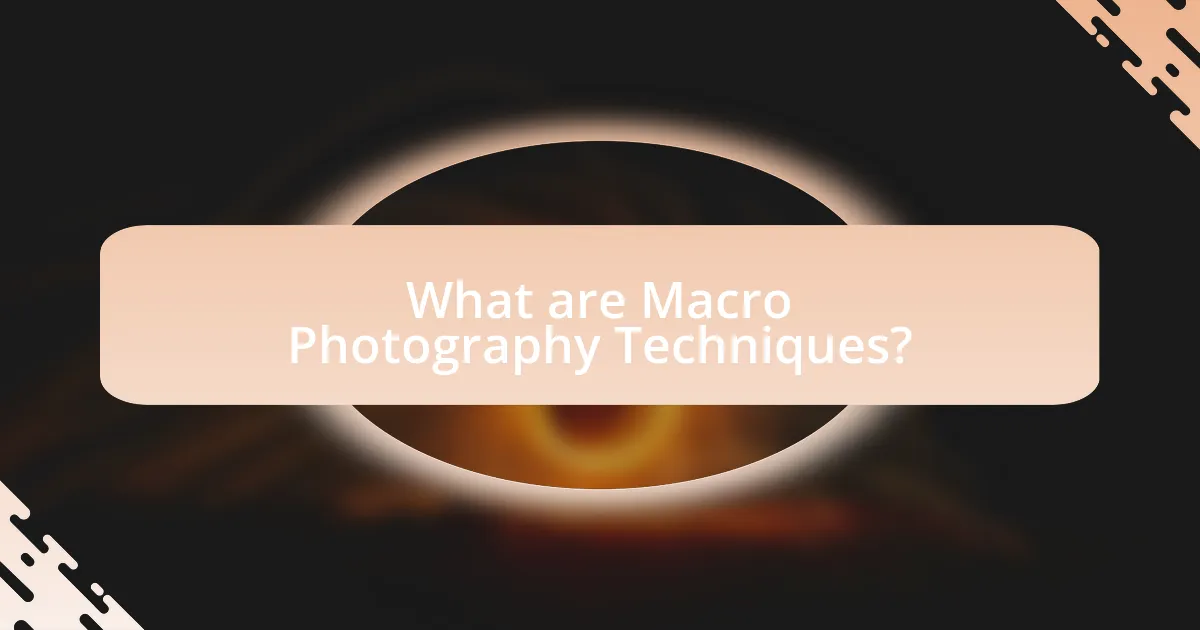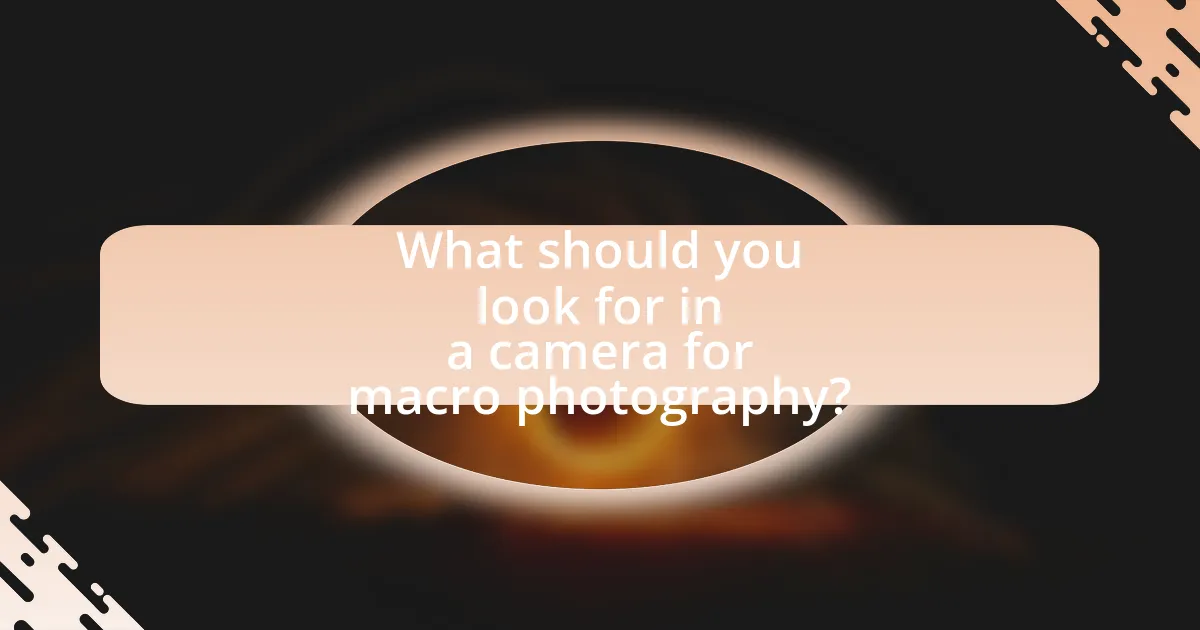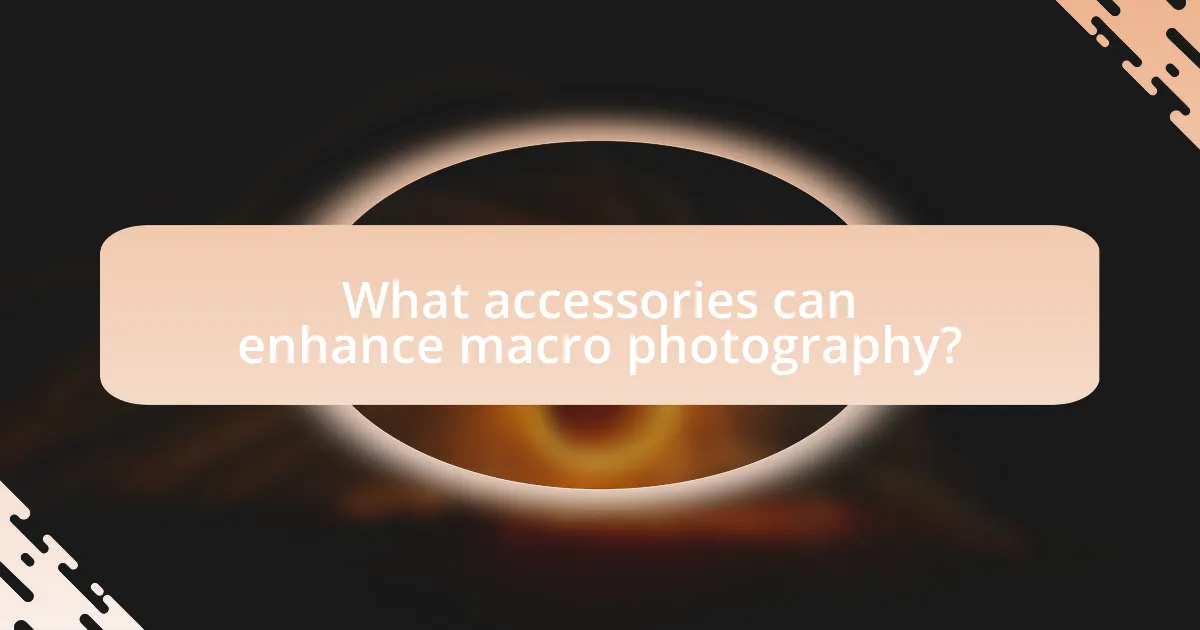Macro photography techniques are specialized methods used to capture close-up images of small subjects, emphasizing intricate details and textures. This article outlines essential techniques such as the use of macro lenses, tripods, and proper lighting to achieve high-quality images. It also discusses the differences between macro photography and other styles, the best subjects for macro work, and the importance of composition and camera features. Additionally, it highlights the role of accessories like extension tubes and ring lights in enhancing macro photography results, providing practical tips for photographers aiming to improve their skills in this detailed art form.

What are Macro Photography Techniques?
Macro photography techniques involve specialized methods to capture close-up images of small subjects, emphasizing detail and texture. Key techniques include using a macro lens, which allows for greater magnification and closer focusing distances, typically achieving a 1:1 reproduction ratio. Additionally, employing a tripod stabilizes the camera to prevent motion blur, while adjusting aperture settings enhances depth of field, allowing for sharp focus on the subject. Lighting techniques, such as using ring lights or diffusers, help illuminate the subject without harsh shadows. These methods are essential for achieving high-quality macro images that reveal intricate details often unseen by the naked eye.
How do Macro Photography Techniques differ from other photography styles?
Macro photography techniques focus on capturing extreme close-up images of small subjects, revealing intricate details that are often invisible to the naked eye. Unlike other photography styles, which may prioritize broader scenes or subjects, macro photography requires specialized equipment such as macro lenses or extension tubes to achieve high magnification levels, typically ranging from 1:1 to 5:1. This level of detail necessitates precise control over depth of field and lighting, as even slight movements can significantly alter the composition. Additionally, macro photography often involves unique challenges such as dealing with shallow depth of field and the need for stable shooting conditions, which differ from the requirements of landscape or portrait photography.
What specific subjects are best suited for macro photography?
In macro photography, the best-suited subjects include insects, flowers, and small objects like jewelry or coins. Insects, such as butterflies and bees, provide intricate details that highlight their textures and colors. Flowers, particularly those with unique patterns or structures, allow for stunning close-up shots that reveal their beauty. Small objects, including everyday items, can be captured in a way that emphasizes their details and craftsmanship. These subjects are ideal because they often possess intricate features that are enhanced through macro techniques, making them visually compelling and interesting to photograph.
Why is lighting important in macro photography?
Lighting is crucial in macro photography because it enhances detail and texture in small subjects. Proper lighting reveals intricate features that may otherwise go unnoticed, allowing for a more vivid and engaging image. For instance, natural light can create soft shadows that add depth, while artificial lighting can be controlled to minimize harsh contrasts. Studies show that optimal lighting conditions can significantly improve the visibility of fine details, making it essential for capturing the essence of macro subjects effectively.
What are the key elements of successful macro photography?
The key elements of successful macro photography include proper lighting, a stable camera setup, and the right lens choice. Proper lighting is essential as it enhances details and colors in close-up shots; natural light or diffused artificial light can minimize harsh shadows. A stable camera setup, often achieved through a tripod, prevents motion blur, which is critical when capturing fine details at close range. The right lens choice, typically a macro lens with a 1:1 magnification ratio, allows for capturing subjects at life-size, ensuring sharp focus and clarity. These elements collectively contribute to high-quality macro images that showcase intricate details effectively.
How does composition play a role in macro photography?
Composition is crucial in macro photography as it determines how the subject is framed and perceived within the image. Effective composition guides the viewer’s eye, enhances the subject’s details, and creates a sense of balance and harmony. Techniques such as the rule of thirds, leading lines, and framing can significantly impact the visual appeal of macro shots. For instance, placing the subject off-center using the rule of thirds can create a more dynamic image, while leading lines can draw attention to intricate details of the subject. Studies in visual perception indicate that well-composed images are more engaging and memorable, reinforcing the importance of composition in capturing the essence of macro photography.
What techniques can enhance detail in macro shots?
To enhance detail in macro shots, photographers can utilize techniques such as proper lighting, using a tripod, and employing focus stacking. Proper lighting, including natural light or diffused artificial light, helps to illuminate fine details and textures, making them more visible. A tripod stabilizes the camera, reducing motion blur and allowing for sharper images, which is crucial in macro photography where even slight movements can affect detail. Focus stacking involves taking multiple images at different focus points and combining them in post-processing to achieve greater depth of field, ensuring that more of the subject is in sharp focus. These techniques are widely recognized in macro photography for their effectiveness in capturing intricate details.

What should you look for in a camera for macro photography?
When selecting a camera for macro photography, prioritize a high-resolution sensor, as it captures fine details essential for close-up shots. A camera with a minimum of 16 megapixels is recommended, as higher resolution allows for better image quality and cropping flexibility. Additionally, look for a camera that offers interchangeable lenses, specifically macro lenses with a 1:1 magnification ratio, which enables capturing subjects at life size. Furthermore, features such as image stabilization help reduce blur from camera shake, enhancing sharpness in macro images. Lastly, consider a camera with manual focus capabilities, as precise focusing is crucial when working with shallow depth of field typical in macro photography.
What camera features are essential for macro photography?
Essential camera features for macro photography include a high-quality macro lens, a reliable autofocus system, and the ability to control aperture settings. A macro lens allows for close-up shots with high detail, typically with a 1:1 magnification ratio, which is crucial for capturing intricate subjects. A reliable autofocus system ensures sharp focus on small subjects, while adjustable aperture settings enable control over depth of field, allowing photographers to isolate subjects effectively. These features collectively enhance the ability to capture detailed and vibrant macro images.
How does sensor size impact macro photography quality?
Sensor size significantly impacts macro photography quality by influencing depth of field, image resolution, and noise levels. Larger sensors, such as full-frame sensors, provide a shallower depth of field, allowing for more pronounced background blur, which enhances subject isolation in macro shots. Additionally, larger sensors typically capture more light, resulting in higher resolution images with finer detail and reduced noise, especially in low-light conditions. For instance, a full-frame sensor can produce images with greater dynamic range and color accuracy compared to smaller sensors, such as those found in crop-sensor cameras. This is crucial in macro photography, where detail and clarity are paramount for capturing intricate subjects.
What is the importance of lens choice in macro photography?
Lens choice in macro photography is crucial because it directly affects the level of detail and clarity captured in close-up images. A dedicated macro lens typically offers a 1:1 magnification ratio, allowing photographers to reproduce subjects at their actual size on the camera sensor, which is essential for capturing intricate details. Additionally, macro lenses are designed with specialized optics that minimize distortion and enhance sharpness, resulting in higher-quality images. For instance, a study by the American Society of Photographers highlights that using a macro lens significantly improves image resolution compared to standard lenses, making it a vital component for achieving professional-level macro photography.
How do different camera types affect macro photography?
Different camera types significantly affect macro photography by influencing factors such as image quality, depth of field, and focusing capabilities. DSLRs and mirrorless cameras typically offer larger sensors, which enhance image quality and allow for better low-light performance, crucial for capturing fine details in macro shots. Additionally, these cameras often support interchangeable lenses, enabling the use of specialized macro lenses that provide higher magnification and sharper images.
In contrast, compact cameras and smartphones generally have smaller sensors, which can limit image quality and depth of field, making it challenging to achieve the same level of detail and background blur as larger cameras. However, some high-end compact cameras and smartphones now feature advanced macro modes and computational photography techniques that can produce impressive results, albeit often with less versatility than dedicated macro systems.
Overall, the choice of camera type directly impacts the effectiveness and quality of macro photography, with larger sensor cameras providing superior performance in capturing intricate details.
What advantages do DSLRs offer for macro photography?
DSLRs offer several advantages for macro photography, primarily due to their larger sensors and interchangeable lenses. The larger sensors in DSLRs capture more light and detail, which is crucial for the intricate textures and colors found in macro subjects. Additionally, the ability to use specialized macro lenses allows photographers to achieve higher magnification and better focus control, enabling precise composition and sharpness. Furthermore, DSLRs typically provide superior autofocus systems and manual control options, which enhance the photographer’s ability to fine-tune settings for optimal results in close-up shots. These features collectively make DSLRs a preferred choice for macro photography.
How do mirrorless cameras compare for macro photography needs?
Mirrorless cameras excel in macro photography due to their compact size, fast autofocus, and electronic viewfinders. Their lightweight design allows for easier handling and stability when capturing close-up images, which is crucial for macro work. Additionally, many mirrorless models feature advanced autofocus systems that can quickly lock onto small subjects, enhancing the likelihood of sharp images. The electronic viewfinder provides real-time exposure and depth-of-field previews, allowing photographers to make precise adjustments before capturing the shot. These features collectively make mirrorless cameras highly suitable for macro photography needs.

What accessories can enhance macro photography?
Accessories that can enhance macro photography include macro lenses, extension tubes, and ring flashes. Macro lenses provide the necessary magnification and sharpness for close-up shots, allowing photographers to capture intricate details of small subjects. Extension tubes increase the distance between the camera and the lens, enabling closer focusing without the need for specialized lenses. Ring flashes offer even lighting around the subject, reducing shadows and enhancing detail in macro images. These accessories are essential for achieving high-quality macro photography, as they directly impact the clarity and detail of the captured images.
What types of lenses are best for macro photography?
The best types of lenses for macro photography are dedicated macro lenses, typically with a focal length of 90mm to 105mm, and extension tubes. Dedicated macro lenses allow for 1:1 magnification, enabling photographers to capture fine details of small subjects. For example, a 100mm macro lens can focus closely on a subject while maintaining sharpness and clarity. Extension tubes, which are placed between the camera body and lens, can also facilitate macro photography by allowing standard lenses to focus closer than their original design permits. This combination of dedicated macro lenses and extension tubes provides versatility and precision in capturing intricate details in macro photography.
How do extension tubes work to improve macro photography?
Extension tubes improve macro photography by increasing the distance between the camera’s lens and the image sensor, allowing for closer focusing on subjects. This increased distance reduces the minimum focusing distance of the lens, enabling photographers to capture detailed images of small subjects, such as insects or flowers, at a higher magnification. Extension tubes do not contain any optical elements, which means they do not degrade image quality, and they are compatible with most lenses, making them a cost-effective solution for achieving macro capabilities.
What role do tripods play in macro photography stability?
Tripods provide essential stability in macro photography by minimizing camera shake and allowing for precise framing. In macro photography, where subjects are often small and details are critical, even slight movements can lead to blurred images. A tripod ensures that the camera remains stationary, enabling longer exposure times without the risk of motion blur. Studies have shown that using a tripod can significantly improve image sharpness, particularly in low-light conditions or when using high magnification ratios, where the depth of field is shallow. This stability is crucial for achieving the desired focus and detail in macro shots.
How can lighting accessories improve macro photography results?
Lighting accessories significantly enhance macro photography results by providing controlled illumination that reduces shadows and highlights intricate details. Proper lighting, such as ring lights or softboxes, allows photographers to illuminate small subjects evenly, which is crucial for capturing textures and colors accurately. For instance, using a ring light can minimize harsh shadows that often obscure fine details in macro shots, leading to clearer and more vibrant images. Studies have shown that optimal lighting conditions can increase the perceived quality of macro photographs, making subjects appear more three-dimensional and visually appealing.
What are the benefits of using ring lights in macro photography?
Ring lights provide even and shadow-free illumination, which is essential in macro photography to highlight intricate details of small subjects. This type of lighting minimizes harsh shadows that can obscure fine textures and colors, allowing for clearer and more vibrant images. Additionally, ring lights often allow for adjustable brightness and color temperature, enabling photographers to customize the lighting to suit different subjects and environments. The consistent light source also helps in achieving accurate color representation, which is crucial for macro photography where color fidelity is important.
How can reflectors enhance lighting in macro shots?
Reflectors enhance lighting in macro shots by directing and diffusing light onto the subject, which helps to illuminate fine details and textures. In macro photography, where subjects are often small and close to the lens, natural light can create harsh shadows or uneven lighting. By using reflectors, photographers can bounce light from various angles, filling in shadows and creating a more balanced exposure. This technique is particularly effective because it allows for greater control over the lighting conditions, improving the overall quality of the image. Studies in photography have shown that well-lit macro images can significantly increase visual appeal and detail clarity, making reflectors an essential tool for achieving professional results.
What are some practical tips for achieving great macro photography?
To achieve great macro photography, use a tripod to stabilize your camera and prevent motion blur. A tripod allows for precise framing and longer exposure times, which are often necessary in macro work due to the shallow depth of field. Additionally, utilize a macro lens designed for close-up shots, as these lenses provide better detail and clarity at close distances.
Employing proper lighting techniques, such as using diffused natural light or external flash, enhances the visibility of fine details and textures in your subject. Furthermore, focus stacking can be beneficial; this technique involves taking multiple images at different focus points and combining them to achieve greater depth of field.
Lastly, practice patience and experimentation with angles and compositions to discover unique perspectives that highlight the intricacies of your subject. These methods are supported by the fact that many professional macro photographers emphasize the importance of stability, specialized equipment, and creative approaches in their work.